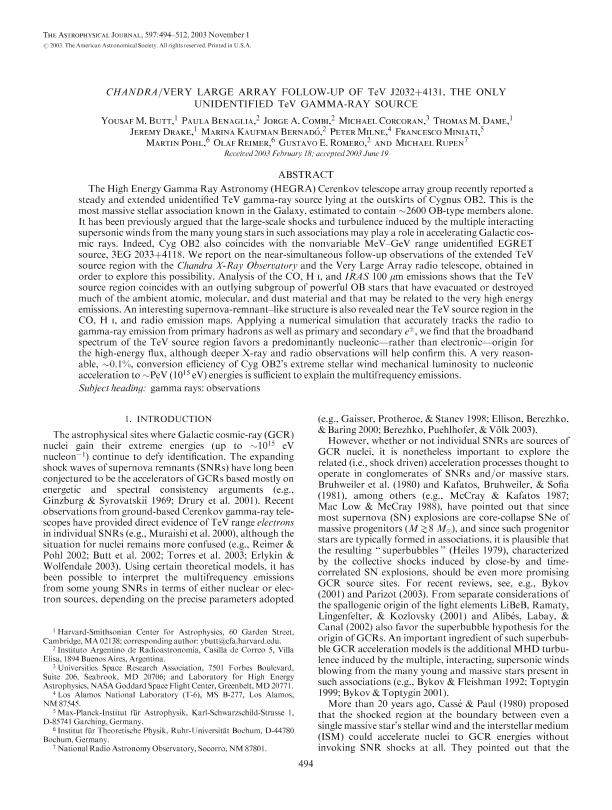Mostrar el registro sencillo del ítem
dc.contributor.author
Butt, Yousaf M.

dc.contributor.author
Benaglia, Paula

dc.contributor.author
Combi, Jorge Ariel

dc.contributor.author
Corcoran, Michael

dc.contributor.author
Dame, Thomas M.

dc.contributor.author
Drake, Jeremy

dc.contributor.author
Kaufman Bernadó, María Marina

dc.contributor.author
Milne, Peter

dc.contributor.author
Miniati, Francesco
dc.contributor.author
Pohl, Martin

dc.contributor.author
Reimer, Olaf

dc.contributor.author
Romero, Gustavo Esteban

dc.contributor.author
Rupen, Michael

dc.date.available
2017-12-07T14:37:06Z
dc.date.issued
2003-12
dc.identifier.citation
Butt, Yousaf M.; Benaglia, Paula; Combi, Jorge Ariel; Corcoran, Michael; Dame, Thomas M.; et al.; Chandra/Very Large Array follow-Up of TeV J2032+4131, the only unidentified TeV gamma-ray source; IOP Publishing; Astrophysical Journal; 597; 12-2003; 494-512
dc.identifier.issn
0004-637X
dc.identifier.uri
http://hdl.handle.net/11336/29925
dc.description.abstract
The High Energy Gamma Ray Astronomy (HEGRA) Cerenkov telescope array group recently reported a steady and extended unidentified TeV gamma-ray source lying at the outskirts of Cygnus OB2. This is the most massive stellar association known in the Galaxy, estimated to contain ~2600 OB-type members alone. It has been previously argued that the large-scale shocks and turbulence induced by the multiple interacting supersonic winds from the many young stars in such associations may play a role in accelerating Galactic cosmic rays. Indeed, Cyg OB2 also coincides with the nonvariable MeV-GeV range unidentified EGRET source, 3EG 2033+4118. We report on the near-simultaneous follow-up observations of the extended TeV source region with the Chandra X-Ray Observatory and the Very Large Array radio telescope, obtained in order to explore this possibility. Analysis of the CO, H I, and IRAS 100 μm emissions shows that the TeV source region coincides with an outlying subgroup of powerful OB stars that have evacuated or destroyed much of the ambient atomic, molecular, and dust material and that may be related to the very high energy emissions. An interesting supernova-remnant-like structure is also revealed near the TeV source region in the CO, H I, and radio emission maps. Applying a numerical simulation that accurately tracks the radio to gamma-ray emission from primary hadrons as well as primary and secondary e+/-, we find that the broadband spectrum of the TeV source region favors a predominantly nucleonic-rather than electronic-origin for the high-energy flux, although deeper X-ray and radio observations will help confirm this. A very reasonable, ~0.1%, conversion efficiency of Cyg OB2's extreme stellar wind mechanical luminosity to nucleonic acceleration to ~PeV (1015 eV) energies is sufficient to explain the multifrequency emissions.
dc.format
application/pdf
dc.language.iso
eng
dc.publisher
IOP Publishing

dc.rights
info:eu-repo/semantics/openAccess
dc.rights.uri
https://creativecommons.org/licenses/by-nc-sa/2.5/ar/
dc.subject
Gamma-Ray Sources
dc.subject.classification
Astronomía

dc.subject.classification
Ciencias Físicas

dc.subject.classification
CIENCIAS NATURALES Y EXACTAS

dc.title
Chandra/Very Large Array follow-Up of TeV J2032+4131, the only unidentified TeV gamma-ray source
dc.type
info:eu-repo/semantics/article
dc.type
info:ar-repo/semantics/artículo
dc.type
info:eu-repo/semantics/publishedVersion
dc.date.updated
2017-11-03T19:34:15Z
dc.journal.volume
597
dc.journal.pagination
494-512
dc.journal.pais
Estados Unidos

dc.journal.ciudad
Chicago
dc.description.fil
Fil: Butt, Yousaf M.. Harvard-Smithsonian Center for Astrophysics; Estados Unidos
dc.description.fil
Fil: Benaglia, Paula. Provincia de Buenos Aires. Gobernación. Comisión de Investigaciones Científicas. Instituto Argentino de Radioastronomía. Consejo Nacional de Investigaciones Científicas y Técnicas. Centro Científico Tecnológico Conicet - La Plata. Instituto Argentino de Radioastronomía; Argentina
dc.description.fil
Fil: Combi, Jorge Ariel. Provincia de Buenos Aires. Gobernación. Comisión de Investigaciones Científicas. Instituto Argentino de Radioastronomía. Consejo Nacional de Investigaciones Científicas y Técnicas. Centro Científico Tecnológico Conicet - La Plata. Instituto Argentino de Radioastronomía; Argentina
dc.description.fil
Fil: Corcoran, Michael. Universities Space Research Association; Estados Unidos
dc.description.fil
Fil: Dame, Thomas M.. Harvard-Smithsonian Center for Astrophysics; Estados Unidos
dc.description.fil
Fil: Drake, Jeremy. Harvard-Smithsonian Center for Astrophysics; Estados Unidos
dc.description.fil
Fil: Kaufman Bernadó, María Marina. Provincia de Buenos Aires. Gobernación. Comisión de Investigaciones Científicas. Instituto Argentino de Radioastronomía. Consejo Nacional de Investigaciones Científicas y Técnicas. Centro Científico Tecnológico Conicet - La Plata. Instituto Argentino de Radioastronomía; Argentina
dc.description.fil
Fil: Milne, Peter. Los Alamos National Laboratory; Estados Unidos
dc.description.fil
Fil: Miniati, Francesco. Max Planck Institut für Astrophysik; Alemania
dc.description.fil
Fil: Pohl, Martin. National Radio Astronomy Observatory; Estados Unidos
dc.description.fil
Fil: Reimer, Olaf. Ruhr-Universität Bochum; Alemania
dc.description.fil
Fil: Romero, Gustavo Esteban. Provincia de Buenos Aires. Gobernación. Comisión de Investigaciones Científicas. Instituto Argentino de Radioastronomía. Consejo Nacional de Investigaciones Científicas y Técnicas. Centro Científico Tecnológico Conicet - La Plata. Instituto Argentino de Radioastronomía; Argentina
dc.description.fil
Fil: Rupen, Michael. National Radio Astronomy Observatory; Estados Unidos
dc.journal.title
Astrophysical Journal

dc.relation.alternativeid
info:eu-repo/semantics/altIdentifier/doi/http://dx.doi.org/10.1086/378121
dc.relation.alternativeid
info:eu-repo/semantics/altIdentifier/url/http://iopscience.iop.org/article/10.1086/378121/meta
Archivos asociados
